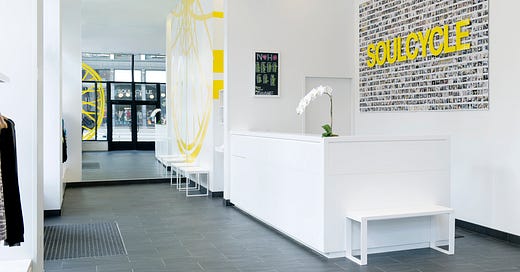
SoulCycle knows that location is everything. Yet, recent missteps in the at-home market have prevented the company from capturing the most valuable real estate of all: the living room.
The Times reports that, despite announcing SoulCycle-branded bikes and an accompanying digital offering for winter 2019, the company did not ship its first physical product until early May 2020. Equinox, SoulCycle’s parent, linked these delays to an unsatisfactory customer experience:
“While the original intent was to launch in Fall 2019, the Equinox Media team was focused on perfecting the experience while in a beta phase, which provided valuable insights on ways to improve the product before launching to members and riders this spring,” a spokeswoman for Equinox Media wrote in an email.
It is difficult to fault SoulCycle for this operational delay. Patrons expect—and pay a premium for—an elevated in-person experience when engaging with the brand. However, the desire to deliver on this brand promise places the company at a distinct disadvantage vis-à-vis emergent at-home competitors, particularly those competing for SoulCycle’s affluent customers.
Why?
Because the at-home market is driven by a different commercial logic than the studio-centric model. In the at-home market:
Hardware is the strategic asset, particularly for the high-end segment
Relative experience matters, but is weighed against absolute convenience
As outlined above, the customer experience will almost always be subordinated to hardware, particularly at the high-end. This subordination follows from two strategic considerations: 1) premium hardware, with its complementary digital content, acts as a platform that can facilitate ecosystem lock-in, and 2) living space is rivalrous, so few customers will ever purchase multiple bikes.
This market logic implies that shipping hardware should take precedence over perfecting the customer experience. Yet, operational delays indicate that SoulCycle failed to internalize this strategic takeaway. Instead, the company executed its standard, studio-centric playbook—which prioritizes the customer experience above all else—despite its inability to deliver incremental strategic advantage in the at-home market.
What are the consequences?
Simply put, this operational misstep prevented SoulCycle from placing more bikes into more living rooms, sooner.
Strategically, the company failed to grow an install base that would help it maintain brand equity and better compete with emergent, at-home players. And tactically, this delay gave competitors such as Peloton the opportunity to encroach on SoulCycle’s loyal customer base, particularly during the shelter-in-place period.
From the same Times piece:
“I was waiting, waiting, waiting because I wanted the SoulCycle bike to come out. They released the pre-order, and I realized they didn’t service the area that I’m in,” said Erica Baddley […] “I would have been first in line.”
Four weeks ago, Ms. Baddley ordered a Peloton.
Churned customers such as Ms. Baddley should worry SoulCycle the most, particularly given how technology and media have changed the experience and economics of at-home fitness. While most attention is given to the cost of a Peloton bike—$2,245 or ~63 SoulCycle classes—the more interesting price is that of the company's monthly subscription service, $39. This commercial model, with high upfront costs and low variable costs, can fundamentally change the economic calculus around in-person and at-home fitness.
For example, Ms. Baddley can access as many live and VOD classes as she wishes on the Peloton service for only $39/mo. This subscription costs slightly more than a single SoulCycle class, which means that if Ms. Baddley—or those like her—plan to ride more than twice a month, then she can obtain a better deal by subscribing to Peloton and forgoing in-studio workouts. Thus, if SoulCycle loses a single customer to Peloton, then Peloton not only captures immediate upfront value; it can also capture all future value associated with that converted customer.
Needless to say, SoulCycle must avoid future missteps that expose the company to such serious strategic and financial downside risks.
Can SoulCycle win?
Fortunately, SoulCycle has time to adapt to—and successfully compete in—the evolving at-home market. This market will continue to grow as technology advances and consumers reassess where and how they exercise. These secular tailwinds gives SoulCycle time to recalibrate its internal organization, make inroads with loyal customers, and compete for ride share.
To make sustainable progress, however, the company must first answer critical strategic questions:
What are the operational implications of servicing two end-markets?
How do customers navigate between the two markets, if at all?
Why choose SoulCycle over another at-home OEM?
Once articulated, these answers will empower SoulCycle to challenge operational orthodoxies and compete more effectively across both the in-person and at-home markets.
And the good news? Another company has shown that this hybrid approach can work.
That company? Peloton.



